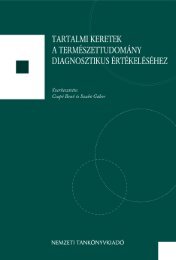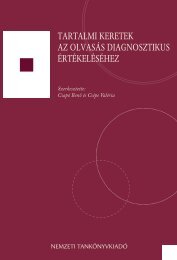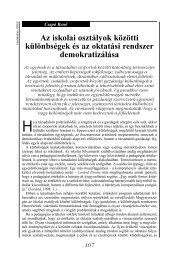Reading motivation of 8â14 year-old students - edu.u-szeged.hu
Reading motivation of 8â14 year-old students - edu.u-szeged.hu
Reading motivation of 8â14 year-old students - edu.u-szeged.hu
You also want an ePaper? Increase the reach of your titles
YUMPU automatically turns print PDFs into web optimized ePapers that Google loves.
University <strong>of</strong> Szeged, Faculty <strong>of</strong> Arts<br />
Graduate School <strong>of</strong> Educational Sciences<br />
Beáta Szenczi<br />
<strong>Reading</strong> <strong>motivation</strong> <strong>of</strong> 8–14 <strong>year</strong>-<strong>old</strong> <strong>students</strong><br />
Theses <strong>of</strong> a PhD Dissertation<br />
Supervisor:<br />
Krisztián Józsa, PhD<br />
Teaching and Learning Doctoral Program<br />
Szeged<br />
2012
INTRODUCTION<br />
<strong>Reading</strong> literacy is crucial for the learning society <strong>of</strong> the 21 st century. The function and the<br />
importance <strong>of</strong> reading have changed in society as well as in <strong>edu</strong>cation as it is the core <strong>of</strong> lifelong<br />
learning and life-wide learning. For this reason its development has become one <strong>of</strong> the<br />
most important goals <strong>of</strong> <strong>edu</strong>cation (OECD, 2006).<br />
<strong>Reading</strong> literacy, in the wider sense, does not only mean the decoding and understanding<br />
<strong>of</strong> written texts but also the willingness to read, the ability to engage in reading and all the<br />
reading motives that make these possible. International studies define reading as<br />
“understanding, using, reflecting on and engaging with written texts, in order to achieve one’s<br />
goals, to develop one’s knowledge and potential, and to participate in society” (OECD, 2009<br />
23. o.). Engagement, in this sense, implies the <strong>motivation</strong> to read and includes a range <strong>of</strong><br />
affective and behavioural processes (Mullis, Kennedy, Martin and Sainsbury, 2006; OECD,<br />
2009).<br />
An individual’s interest in reading, their attitudes towards reading and the time spent with<br />
reading are all in a strong relationship with reading comprehension (Cox and Guthrie, 2001).<br />
The more motivated an individual is to read, the more time they will spend on reading, which<br />
will consequently provide more opportunities for practice. This kind <strong>of</strong> individual practice can<br />
compensate for an unfavourable socioeconomic background (Kirsch, deJong, Lafontaine,<br />
McQueen, Mendelovits and Monseur, 2002) or for <strong>year</strong>s <strong>of</strong> school failure (Guthrie and<br />
Wigfield, 2000). The system <strong>of</strong> motives and skills are in a strong relationship with each other<br />
(Józsa, 2005), therefore shaping reading <strong>motivation</strong>, besides improving skills, is one <strong>of</strong> the<br />
basic responsibilities <strong>of</strong> school.<br />
National and international large-scale studies all point out that the reading performance <strong>of</strong><br />
Hungarian <strong>students</strong> does not meet the expectations <strong>of</strong> the 21 st century (Csíkos, 2006; Horváth,<br />
1994, 1996; Vári, 2003). Besides reading comprehension, international studies have also<br />
examined the underlying affective and <strong>motivation</strong>al processes <strong>of</strong> reading. According to the<br />
results, Hungarian <strong>students</strong> are also lagging behind in the development <strong>of</strong> reading motives<br />
(Artelt, Baumert, Julius-Mc-Elvany and Peschar, 2003). As a response to these results, there<br />
has been an outgrowth <strong>of</strong> research to explore reading skills and to discover possible ways <strong>of</strong><br />
improvement in Hungary (see, for example, Józsa, 2006). However, the underlying<br />
<strong>motivation</strong>al aspects <strong>of</strong> the development process have not been emphasized to the same<br />
extent. Research is needed to explore how <strong>students</strong> in Hungary feel about reading, what they<br />
prefer to read, how much they read, why they read, what they think about their own reading<br />
skills and reading performance and what factors influence all these.<br />
The aim <strong>of</strong> this thesis is to describe a theoretical framework for operationalizing reading<br />
<strong>motivation</strong> as the drive for reading. In order to reach this aim, we need to thoroughly review<br />
the international literature on reading and learning <strong>motivation</strong>. In our empirical research, we<br />
map reading motives <strong>of</strong> elementary school <strong>students</strong> in order to describe their characteristics,<br />
to discover their link to performance and to investigate some factors affecting them.<br />
3
THEORETICAL BACKGROUND<br />
Learning <strong>motivation</strong> theories have revealed a complex system <strong>of</strong> motives (Józsa, 2007).<br />
Research <strong>of</strong> the past decades have focused on specific motives <strong>of</strong> learning <strong>motivation</strong> like<br />
goals (Elliot, 1997; Harter, 1981; Pintrich and Sc<strong>hu</strong>nk, 1996) or academic self-concept<br />
(Marsh and Craven, 1997; Van Damme, Opdenakker, de Fraine and Mertens, 2004) across<br />
skills and domains.<br />
However, research findings suggest that examining domain- or skill-specific motives<br />
provide more detailed information on the operation and nature <strong>of</strong> motives than examining<br />
learning motives in general, although it is yet to be explored whether the above mentioned<br />
<strong>motivation</strong>al constructs represent the same mechanisms in all ages and domains. Learning<br />
motives initiate and support a wide range <strong>of</strong> activities in the different areas <strong>of</strong> learning;<br />
therefore it cannot be assumed that they operate in exactly the same way across domains.<br />
Research has shown, for example, that school-aged children believe some <strong>of</strong> their skills are<br />
easier to develop than others, consequently, they put more effort in the improvement <strong>of</strong> these<br />
skills (Freedman-Doan, Wigfield, Eccles, Blumenfeld, Arbreton and Har<strong>old</strong>, 2000). For<br />
example, a student may feel that they are hopeless in mathematics, but their abilities are<br />
promising in terms <strong>of</strong> reading. Besides differences in quality, domain-specific motives differ<br />
in terms <strong>of</strong> quantity. Learning <strong>motivation</strong> constructs like interest, perceived competence,<br />
intrinsic <strong>motivation</strong> or self-efficacy can be stronger in one domain and weaker in another at<br />
the same time (Eccles, Wigfield, Har<strong>old</strong> and Blumenfeld, 1993). For example, an individual<br />
can have a strong sense <strong>of</strong> self-efficacy or a positive self-concept in reading, but a weak sense<br />
<strong>of</strong> self-efficacy and low self-concept in mathematics.<br />
Research in Hungary identifies reading <strong>motivation</strong> as an interest in a specific content or<br />
genre – most commonly, in a canon <strong>of</strong> literature. International studies proceeding from the<br />
domain-specific nature <strong>of</strong> learning <strong>motivation</strong> define reading <strong>motivation</strong> on a broader,<br />
dynamic level and identifies it as a complex system <strong>of</strong> multiple components. This corresponds<br />
to the definition <strong>of</strong> OECD. Following the framework <strong>of</strong> learning <strong>motivation</strong> theory,<br />
international reading <strong>motivation</strong> research has successfully identified several components <strong>of</strong><br />
reading <strong>motivation</strong> already known from learning <strong>motivation</strong> research as well as some domainspecific<br />
reading motives. These components are briefly reviewed below.<br />
<strong>Reading</strong> self-concept: Empirical research on the structure <strong>of</strong> self-concept (Józsa, 1999;<br />
Marsh, 1990) have proven that there is not only one learning self-concept but several,<br />
relatively independent subject- and skill-specific self-concepts that are in a loose relationship<br />
with each other. <strong>Reading</strong> self-concept is one <strong>of</strong> these skill-specific self-concepts. The<br />
hierarchical, multidimensional Marsh/Shavelson model <strong>of</strong> academic self-concept identifies<br />
reading self-concept as <strong>students</strong>’ own evaluations their reading skills, abilities and interests<br />
(Marsh, 1993).<br />
<strong>Reading</strong> self-efficacy: In the reading <strong>motivation</strong> model <strong>of</strong> Wilson and Trainin (2007)<br />
reading self-efficacy was defined as the perception <strong>of</strong> <strong>students</strong> on how well they would<br />
perform on a specific reading task such as on the spelling <strong>of</strong> words. Guthrie, Hoa, Wigfield,<br />
Tonks, Humenick and Littles (2006), however, provide a more comprehensive definition and<br />
regard one’s own subjective ability beliefs and expectancies as crucial constructs <strong>of</strong> selfefficacy.<br />
The value <strong>of</strong> reading: Expectancy-value theory (Wigfield and Eccles, 2000) argues that<br />
individuals’ level <strong>of</strong> <strong>motivation</strong> increases in line with the subjective expectation for success<br />
4
and task value. The more chance the individual believes to have to successfully complete a<br />
task and the more valuable an individual thinks the task is, the more motivated they are to<br />
perform it. There are different components <strong>of</strong> the value attributed to a specific task (Wigfield<br />
and Eccles, 2000). Utility value or usefulness refers to the subjective opinion <strong>of</strong> the individual<br />
on how useful the task or the acquisition <strong>of</strong> an ability is in performing other tasks (Eccles et<br />
al., 1983). For example, if <strong>students</strong> believe learning to read well is important from the<br />
perspective <strong>of</strong> their future welfare, they are more likely to put much effort in learning and<br />
practicing it. Attainment value or importance, that is, an individual’s perception on how<br />
important it is for them to perform well on a given task, works similarly. If it is important for<br />
<strong>students</strong> to learn to read well in order to be able to use their skills effectively, they are<br />
motivated to read (Wigfield and Eccles, 2000).<br />
Goal orientations in reading: Goal orientation theory examines the reasons why and how<br />
<strong>students</strong> engage in given tasks, for example in reading tasks. Dweck and Leggett (1988)<br />
identify two types <strong>of</strong> goals in achievement situations: mastery goals and performance goals.<br />
Mastery goal refers to the intention <strong>of</strong> the individual to increase their competence, while<br />
performance goal refers to the intention to get one’s competence acknowledged by others<br />
(Fejes, 2011; Józsa, 2007). Another dimension to differentiate between goals is the approachavoidance<br />
dimension, that is, whether the individual seeks achievement situations or tries to<br />
avoid them (Linnenbrink and Pintrich, 2001). There are four types <strong>of</strong> goals to the above<br />
mentioned dimensions: mastery approach, mastery avoidance, performance approach and<br />
performance avoidance (Fejes, 2011).<br />
Social motives <strong>of</strong> reading: Wigfield and Guthrie (1997) defined social motives as domainspecific<br />
motives <strong>of</strong> reading <strong>motivation</strong>. This broad category includes all motives that are<br />
aimed at sharing the meaning gained from reading with others (Wigfield, Guthrie and<br />
McGough, 1996).<br />
Interest in reading, attitudes: Interest as a motive is a psychological state which drives the<br />
individual to engage and re-engage in certain group <strong>of</strong> ideas, events and objects (Hidi and<br />
Renninger, 2006). Interest in reading is always the result <strong>of</strong> the interaction between an<br />
individual and a specific content (Krapp, 2000), that is, it is content-specific, it cannot be<br />
interpreted across tasks. Inherited curiosity and learned attitudes are both considered as the<br />
basis <strong>of</strong> interest (Nagy, 2000). Alexander and Filler (1976) defined reading-specific attitudes<br />
as a system <strong>of</strong> reading-related emotions, which drive the individual to approach or avoid<br />
reading situations (Alexander and Filler, 1976, p1).<br />
Flow in reading: Flow as defined by Csíkszentmihályi (1991) is not a single motive but<br />
rather a psychological state that is the result <strong>of</strong> the simultaneous workings <strong>of</strong> several motives.<br />
According to flow theory, when one is fully immersed in something, they get into an optional<br />
emotional state. This optimal mental state is self-rewarding, t<strong>hu</strong>s it drives the individual to<br />
repeat and continue the activities causing flow. That is to say, flow results in experience<br />
driven <strong>motivation</strong>. Csíkszentmihályi (1991) describes reading as a typical flow activity.<br />
International research examines the above mentioned motives in different ways. One<br />
tradition studies only one motive already identified in learning <strong>motivation</strong> at a time and draws<br />
conclusions in the domain <strong>of</strong> reading – and, quite <strong>of</strong>ten, in other domains like Maths at the<br />
same time. Another tradition, also studying one motive at a time, starts out from the domainspecific<br />
nature <strong>of</strong> learning motives and regards the reading motive a domain-specific learning<br />
motive. These studies measure the single reading motive along with other domain-specific<br />
learning motives (for example reading self-concept and mathematics self-concept) at the same<br />
5
time. Sometimes this single motive is reading <strong>motivation</strong> itself as a unidimensional construct.<br />
A third tradition <strong>of</strong> reading <strong>motivation</strong> research uses multi-motive surveys to map a multicomponent<br />
model <strong>of</strong> reading <strong>motivation</strong>. Questionnaires are most <strong>of</strong>ten used to explore<br />
reading <strong>motivation</strong> as a complex construct on its own, but we can also find examples <strong>of</strong><br />
interviews in the literature.<br />
AIMS AND HYPOTHESES<br />
The aim <strong>of</strong> our research is to map the reading <strong>motivation</strong> <strong>of</strong> elementary school <strong>students</strong> in<br />
Hungary, to explore the factors that affect it and to discover its relationship with reading<br />
performance. Two pilot studies and a major research were carried out. The first pilot looked<br />
at one <strong>of</strong> the motives <strong>of</strong> reading, namely reading self-concept, while the second one examined<br />
reading <strong>motivation</strong> as a single, unidimensional construct. The first survey, carried out with<br />
Krisztián Józsa, focused on reading self-concept as a fundamental component <strong>of</strong> learning selfconcept<br />
(Szenczi and Józsa, 2008, 2009). The aim was to capture the domain-specific nature<br />
<strong>of</strong> self-concept. In other words, our goal was to explore the relationship <strong>of</strong> reading selfconcept<br />
as a reading motive with other domain-specific self-concepts. Hypotheses <strong>of</strong> the first<br />
pilot study are as follows:<br />
H 1 : Domain-specificity: Self-components already identified by international literature can<br />
be found among Hungarian <strong>students</strong> as well. The different self-concepts can be isolated<br />
from each other.<br />
H 2 : Characteristics <strong>of</strong> self-components: The majority <strong>of</strong> elementary school <strong>students</strong> have<br />
positive self-concepts, but there are significant differences in the characteristics <strong>of</strong> these<br />
self-concepts. The level <strong>of</strong> self-concept declines with age. As for academic self-concepts,<br />
reading self-concept declines slower than mathematics self-concept.<br />
H 3 : Intercorrelation: The relationship between the different self-components is moderate.<br />
The structure <strong>of</strong> self-concept is hierarchical. Domain-specific learning related self-concepts<br />
form an academic self-concept on a higher level <strong>of</strong> the hierarchy. On the highest level,<br />
self-components are structured into a general self-concept.<br />
H 4 : The relationship between self-components and performance: There is a relationship<br />
between self-concept and performance. Self-components <strong>of</strong> a given domain have the<br />
strongest relationship with performance in that domain. For example, reading self-concept<br />
is most strongly linked to reading comprehension performance and reading grade.<br />
H 5 : External links: There is a link between self-components and certain characteristics <strong>of</strong><br />
the family background and between self-components and IQ. There is a strong relationship<br />
between self-concept in a given subject and attitudes to that subject. In other words,<br />
<strong>students</strong> presumably prefer subjects they think they are good at. Significant differences are<br />
assumed between male and female <strong>students</strong> regarding the level <strong>of</strong> the different selfcomponents.<br />
The second pilot study examined unidimensional reading <strong>motivation</strong> among <strong>students</strong> with<br />
and without general learning disabilities. The study was carried out by Krisztián Józsa, Margit<br />
Fazekasné Fenyvesi, Rita Kelemen and Beáta Szenczi (Józsa and Fazekasné, 2008; Kelemen,<br />
Józsa and Szenczi, 2010). It was an important antecedent to our central study as it was the first<br />
6
study to examine Hungarian <strong>students</strong>’ reading <strong>motivation</strong> while comparing <strong>students</strong> with and<br />
without general learning disabilities. The hypotheses <strong>of</strong> the second pilot study were:<br />
H 1 : <strong>Reading</strong> <strong>motivation</strong> <strong>of</strong> <strong>students</strong> declines with age.<br />
H 2 : There are crucial differences between the reading <strong>motivation</strong> <strong>of</strong> <strong>students</strong> with and<br />
without general learning disabilities. The level <strong>of</strong> reading <strong>motivation</strong> among <strong>students</strong> with<br />
learning disabilities is lower in all grades than the level <strong>of</strong> reading <strong>motivation</strong> among<br />
majority <strong>students</strong>.<br />
H 3 : <strong>Reading</strong> comprehension performance and word reading skills are both linked to<br />
reading <strong>motivation</strong>.<br />
H 4 : Family background, gender and IQ all relate to reading <strong>motivation</strong>.<br />
Our major study examines reading <strong>motivation</strong> as a domain-specific, multidimensional<br />
construct. In our research, reading <strong>motivation</strong> is defined as multi-component system <strong>of</strong><br />
domain-specific motives that play a role in initiating and continuing a reading activity as well<br />
as in engaging in reading regardless <strong>of</strong> the content. <strong>Reading</strong> <strong>motivation</strong> as a unique construct<br />
is a system <strong>of</strong> motives, that is, a system <strong>of</strong> internal components serving as benchmarks <strong>of</strong> the<br />
reading behaviour.<br />
Our research covers the elementary level. The reason for examining this population is the<br />
well-established finding <strong>of</strong> the literature that the process <strong>of</strong> learning to read and the affective<br />
experiences gained during the process have an impact on the learning process in all other<br />
domains as well as on the level <strong>of</strong> <strong>motivation</strong> in these domains later on (Chapman and<br />
Tunmer, 2002). Exploring the characteristics <strong>of</strong> reading <strong>motivation</strong> and mapping its<br />
development can serve as the basis for studying learning <strong>motivation</strong> as a domain-specific<br />
construct in other areas as well.<br />
In Hungary, the content-independent, multi-component model <strong>of</strong> reading <strong>motivation</strong> has<br />
not been established yet, nor is there a well-established model <strong>of</strong> reading <strong>motivation</strong> in<br />
international literature. Due to the lack <strong>of</strong> these, there are no empirically validated instruments<br />
to measure it. Therefore, our first aim was to develop instruments that enable the measuring <strong>of</strong><br />
reading <strong>motivation</strong> on the elementary level. In order to realize this aim, we need to thoroughly<br />
examine the international literature <strong>of</strong> reading <strong>motivation</strong> and adapt multiple models to the<br />
Hungarian circumstances. Once the instruments are developed, we aim to explore the<br />
characteristics <strong>of</strong> the reading motives <strong>of</strong> Hungarian <strong>students</strong>. The two crucial factors affecting<br />
the development <strong>of</strong> reading ability and reading motives, home and school context, are also<br />
investigated. Hypotheses <strong>of</strong> the central study are grouped into 5 categories.<br />
1. Measurement:<br />
H 1 : Structured and semi-structured interviews are reliable sources <strong>of</strong> information to draw<br />
conclusions on the workings <strong>of</strong> reading motives at the beginning <strong>of</strong> the process <strong>of</strong> learning<br />
to read.<br />
H 2 : Questionnaires are reliable sources <strong>of</strong> information to draw conclusions on the operation<br />
<strong>of</strong> reading motives at later phases <strong>of</strong> the process <strong>of</strong> learning to read.<br />
H 3 : Factor analysis confirms the existence <strong>of</strong> motives discussed in the literature <strong>of</strong> learning<br />
and reading <strong>motivation</strong> in the Hungarian sample.<br />
H 4 : Semi-structured interviews are reliable means <strong>of</strong> studying the sources <strong>of</strong> self-concepts<br />
and the goals <strong>of</strong> learning to read among second-grade <strong>students</strong>.<br />
7
H 5 : Word reading with pictures is a reliable way <strong>of</strong> drawing conclusions on the workings<br />
<strong>of</strong> the word reading skill in grade 2.<br />
H 6 : <strong>Reading</strong> comprehension tests are reliable ways <strong>of</strong> drawing conclusions on the workings<br />
<strong>of</strong> reading comprehension skills in grade 4, 6 and 8.<br />
2. Motives:<br />
H 7 : At the beginning <strong>of</strong> the process <strong>of</strong> learning to read, <strong>students</strong> are highly motivated.<br />
H 8 : The strength <strong>of</strong> motives gradually decreases in upper grades.<br />
H 9 : There are significant differences in the motives in different grades.<br />
H 10 : Even from the beginning, there are several distinctive features in the strength <strong>of</strong><br />
motives between the two genders.<br />
3. Intercorrelation:<br />
H 11 : <strong>Reading</strong> motives are interrelated from the onset <strong>of</strong> the learning process.<br />
H 12 : There is a stronger relationship within motives belonging to a certain category (values<br />
and expectancies) than the relationship between different categories.<br />
H 13 : The relationship between the different categories is stronger in the upper grades than<br />
in the lower grades.<br />
4. Motives and performance:<br />
H 14 : There is a positive relationship between the reading motives and reading performance.<br />
H 15 : The strength <strong>of</strong> this relationship changes as a function <strong>of</strong> the indicator <strong>of</strong> reading<br />
performance: correlation between reading motives and grades, and reading motives and<br />
reading test results are different.<br />
H 16 : The correlation <strong>of</strong> reading motives and grades is stronger than the correlation <strong>of</strong><br />
reading motives and reading skills as measured by standardized tests.<br />
H 17 : Students with highly developed reading skills are not necessarily motivated to learn.<br />
H 18 : <strong>Reading</strong> <strong>motivation</strong> partly explains individual differences in reading ability.<br />
5. External links:<br />
H 19 : <strong>Reading</strong> motives <strong>of</strong> <strong>students</strong> are linked to certain aspects <strong>of</strong> the home and school<br />
environment.<br />
H 20 : Feedback from the teacher as well as from the parents has a strong impact on <strong>students</strong>’<br />
reading motives at the beginning <strong>of</strong> the process <strong>of</strong> learning to read.<br />
H 21 : Students’ goals <strong>of</strong> learning to read are shaped by parents’ and teachers’ practices.<br />
H 22 : There is a link between certain features <strong>of</strong> one’s family background and their reading<br />
motives.<br />
Results <strong>of</strong> our central study concerning the features <strong>of</strong> the school environment have paved<br />
the way for an additional survey on the beliefs <strong>of</strong> teacher trainees and practicing teachers<br />
about reading, the process <strong>of</strong> learning to read and about reading <strong>motivation</strong>. A small-scale<br />
study was carried out to analyse beliefs <strong>of</strong> teachers and teachers-to-be. The study used<br />
quantitative and qualitative methods and was carried out with Zsuzsanna Nagy. Hypotheses <strong>of</strong><br />
the additional survey are as follows:<br />
8
H 1 : Both teacher trainees and teachers define reading as an ability. The two most important<br />
components <strong>of</strong> this ability are decoding and understanding.<br />
H 2 : Both teacher trainees and teachers apply a narrow definition <strong>of</strong> reading <strong>motivation</strong> and<br />
regard it as a construct having to do with interest for certain texts and the frequency <strong>of</strong><br />
reading activities.<br />
H 3 : In line with the definition described above, teacher trainees and teacher-practitioners<br />
believe the best way to develop reading <strong>motivation</strong> is to provide <strong>students</strong> with interesting<br />
texts to read in order to arouse their interest in reading.<br />
H 4 : There is a significant difference between the definitions and preferred methods <strong>of</strong><br />
teacher trainees and practicing teachers. This difference can be attributed to experience.<br />
METHODS<br />
During the first pilot study, we adapted the SDQ-I (Self-Description Questionnaire I), which<br />
is based on the Marsh/Shavelson model <strong>of</strong> hierarchical self-concept. The Hungarian<br />
instrument consisted <strong>of</strong> 76 self-evaluating Likert-scale items just like the English original.<br />
Students from grade 3 (N=218), grade 5 (N=194) and grade 7 (N=174) participated in the<br />
survey (N=586). The ratio <strong>of</strong> males and females was the same in all sub-samples. 59% <strong>of</strong> the<br />
participants were male in grade 3, 56% in grade 5, 51% in grade 7. Data were collected at the<br />
beginning <strong>of</strong> 2008.<br />
The second, one-dimensional pilot study aimed at the study <strong>of</strong> unidimensional reading<br />
<strong>motivation</strong>. The questionnaires were filled out by majority <strong>students</strong> and <strong>students</strong> with general<br />
learning disabilities in grade 3 (N non-LD =298; N LD =236), grade 5 (N non-LD = 323; N LD =148) and<br />
7 (N non-LD =319; N LD =226). We used 3-point Likert-scale items. The instrument was<br />
developed on the basis <strong>of</strong> Falus (2003). Data collection took place in the first quarter <strong>of</strong> 2008.<br />
The major, empirical study looked at ten components <strong>of</strong> reading <strong>motivation</strong>. Based on the<br />
adaptation <strong>of</strong> national and international instruments, we have prepared two versions <strong>of</strong> the<br />
questionnaire to measure these motives: one to be used in grades 1 and 2 <strong>of</strong> the elementary<br />
school and another one to be used in upper grades <strong>of</strong> the elementary school. <strong>Reading</strong> motives<br />
were studied with the help <strong>of</strong> structured and semi-structured interviews in the lower grade<br />
(grade 2); while in upper grades (grade 4, 6, and 8) the questionnaires were filled out by the<br />
<strong>students</strong> themselves. In grade 2, the questionnaire included open-ended questions, which were<br />
aimed at the sources <strong>of</strong> reading self-concept as well as the goals <strong>of</strong> learning to read. Answers<br />
were audio recorded, and analysed by the method <strong>of</strong> content analysis. <strong>Reading</strong> tests were used<br />
to evaluate the reading performance <strong>of</strong> <strong>students</strong>. In grade 2, we used the test called Word<br />
reading through pictures (Nagy, 2006), in grade 4, 6 and 8 we used reading comprehension<br />
tests developed by Krisztián Józsa and Mihály Hrabovszky. Based on the PIRLS (Progress in<br />
International <strong>Reading</strong> Literacy Study) background questionnaires, we developed<br />
questionnaires for parents and for teachers to map the aspects <strong>of</strong> the family and the school<br />
context. Participants <strong>of</strong> the study were <strong>students</strong> from grade 2 (N=135), grade 4 (N=218),<br />
grade 6 (N=278) in 24 elementary schools from 3 counties, Csongrád, Pest and Bács-Kiskun.<br />
This involved 890 <strong>students</strong> in total. Data were collected in November, 2010. Additional<br />
surveys were carried out to study the reading- and reading <strong>motivation</strong>-related beliefs <strong>of</strong><br />
teacher trainees and practicing teachers. The small-scale survey involved 37 teacher trainees<br />
being in their second or third <strong>year</strong> <strong>of</strong> studies and 60 teacher-practitioners. About half <strong>of</strong> the<br />
9
teacher-practitioners had more than 10 <strong>year</strong>s <strong>of</strong> experience in the field <strong>of</strong> teaching. The<br />
questionnaire consisted <strong>of</strong> Likert-scale items and open-ended questions. Data were collected<br />
online at the beginning <strong>of</strong> 2011.<br />
RESULTS<br />
<strong>Reading</strong> motives <strong>of</strong> Hungarian <strong>students</strong> were explored through one major study and three<br />
additional ones. The basis <strong>of</strong> the empirical research is a major study, which was preceded by<br />
two pilot studies and followed by an additional survey. After briefly summarizing the<br />
objectives <strong>of</strong> the individual studies, results <strong>of</strong> the empirical research are described by the<br />
hypotheses stated above.<br />
The first pilot study examined the relationship <strong>of</strong> a reading motive, reading self-concept to<br />
performance, attitudes and other self-components. The domain-specific nature <strong>of</strong> motives was<br />
first described by studies on self-concept. Research results conclude that there is not one,<br />
comprehensive learning self-concept, but different domain- and skill-specific self-concepts.<br />
Our pilot study on self-concept aimed at exploring whether self-components described by<br />
international models can be identified and isolated among Hungarian <strong>students</strong> as well. We<br />
also aimed at mapping reading self-concept in the hierarchy <strong>of</strong> self-concepts.<br />
Hypotheses were grouped into five categories. Results <strong>of</strong> the first pilot study are discussed<br />
in line with these categories as follows:<br />
H 1 : Domain-specificity: Our results show that the self-components identified by<br />
international research can also be identified among Hungarian <strong>students</strong>. Moreover, selfcomponents<br />
can be isolated in student’s thinking. This result underlines the domainspecificity<br />
<strong>of</strong> self-concept. Based on this result we have a reason to hypothesize that other<br />
motives are also domain-specific.<br />
H 2 : Characteristics <strong>of</strong> self-components: Our data shows that the majority <strong>of</strong> elementary<br />
school <strong>students</strong> have a positive self-concept, but characteristics <strong>of</strong> the different selfcomponents<br />
differ among them. The <strong>old</strong>er the <strong>students</strong> are, the lower the level <strong>of</strong> self-concept<br />
is among them. Although reading self-concept does not decline as much as mathematics self<br />
concept, its decline is significant.<br />
H 3 : Intercorrelation: There is a moderate relationship between self-components. Analysis<br />
<strong>of</strong> the structure <strong>of</strong> self-concept confirmed that the different learning-related self-concepts do<br />
not form one academic self-concept on a higher level <strong>of</strong> the hierarchy. School self-concept<br />
has the strongest link to reading self-concept in upper grades, while Mathematics self-concept<br />
gradually becomes independent <strong>of</strong> other academic self-components. This result underlines<br />
those international findings that suggest reading self-concept plays an important role in the<br />
development <strong>of</strong> general school self-concept, and, presumably, it is the basis <strong>of</strong> other learningrelated<br />
self-concepts. Therefore, we have a reason to believe that reading-related motives play<br />
a central role in the development <strong>of</strong> all learning motives.<br />
H 4 : The relationship between self-components and performance: There is a relationship<br />
between self-concept and performance. Specific domain-specific self-components have the<br />
strongest relationship with the performance in that given domain. For example, reading selfconcept<br />
has a strong relationship with reading comprehension and with reading grade. The<br />
strength and direction <strong>of</strong> this relationship depends on the performance indicator chosen, i.e.<br />
10
on whether we use grades or skills as performance indicators. <strong>Reading</strong> self-concept is only<br />
affected by grades.<br />
H 5 : External links: Self-components are linked to certain characteristics <strong>of</strong> the family<br />
background as well as to IQ. There is a significant difference in the self-concepts <strong>of</strong> <strong>students</strong><br />
with parents with different school qualifications: <strong>students</strong> whose parents have higher<br />
qualifications have a higher level <strong>of</strong> self-concept in reading. We can also see a link between<br />
preferences towards certain subjects and the level <strong>of</strong> self-concept in those domains. In upper<br />
grades, <strong>students</strong> prefer those subjects in which they think their performance is better.<br />
Our second pilot study examined reading <strong>motivation</strong> from a unidimensional perspective. In<br />
the second pilot study reading <strong>motivation</strong> was regarded as an individual, homogeneous<br />
system. The aim was to map the development process <strong>of</strong> reading <strong>motivation</strong> in general and to<br />
discover its link to performance and other variables like IQ and gender. Our research provided<br />
the opportunity to examine the impacts <strong>of</strong> different developmental paths on reading<br />
<strong>motivation</strong> as a complex construct. Our survey involved <strong>students</strong> with and without general<br />
learning disabilities. Data were collected in 2008.<br />
Results confirmed that the instrument developed works well both with majority <strong>students</strong><br />
and <strong>students</strong> with general learning disabilities. Simplified, three-point Likert-scale items made<br />
it easier for <strong>students</strong> with learning disabilities to fill in the questionnaire. Reliability <strong>of</strong> the<br />
instrument is satisfactory among these <strong>students</strong> as well. Further results categorized by the<br />
hypotheses are as follows:<br />
H 1 : Age: Results <strong>of</strong> the cross-sectional study showed that the level <strong>of</strong> reading <strong>motivation</strong><br />
declines with age among <strong>students</strong>.<br />
H 2 : Different developmental paths: The hypothesis that there is a significant difference<br />
between the reading <strong>motivation</strong> <strong>of</strong> majority <strong>students</strong> and the reading <strong>motivation</strong> <strong>of</strong> <strong>students</strong><br />
with general learning disabilities was partly confirmed. The difference between the two<br />
subsamples <strong>of</strong> <strong>students</strong> is significant in grades 3 and 5. In these classes the level <strong>of</strong> reading<br />
<strong>motivation</strong> <strong>of</strong> <strong>students</strong> with general learning disabilities is significantly lower than that <strong>of</strong><br />
majority <strong>students</strong>. In grade 8, however, there is no significant difference in the level <strong>of</strong><br />
<strong>motivation</strong> <strong>of</strong> the two groups.<br />
H 3 : <strong>Reading</strong> <strong>motivation</strong> and performance: At the beginning <strong>of</strong> our research, we assumed<br />
that both reading comprehension and word reading skills are linked to reading <strong>motivation</strong>.<br />
Results, however, did not confirm this hypothesis. There is no relationship between word<br />
reading skills and reading <strong>motivation</strong>. The relationship between reading comprehension<br />
performance and reading <strong>motivation</strong> is moderate. The situation is the same among <strong>students</strong><br />
with learning disabilities.<br />
H 4 : Family background, gender and IQ are all related to reading <strong>motivation</strong>. However,<br />
correlations are low. IQ and school qualification <strong>of</strong> the father have a moderate relationship<br />
with reading <strong>motivation</strong>, and this relationship is not significant among <strong>students</strong> with general<br />
learning disabilities. Therefore, we hypothesize reading <strong>motivation</strong> is shaped by other factors<br />
such as certain characteristics <strong>of</strong> the activities aiming at developing reading skills at home and<br />
at school.<br />
Our major survey was designed in line with the international literature in the field and the<br />
results <strong>of</strong> our two pilot studies. Our aim was to get a global picture <strong>of</strong> the reading <strong>motivation</strong><br />
<strong>of</strong> elementary school <strong>students</strong>, to discover the factors affecting it and to explore its<br />
relationship to reading performance. Our major survey defined reading <strong>motivation</strong> as a multicomponent<br />
system <strong>of</strong> reading motives. We examined ten reading motives among elementary<br />
11
school <strong>students</strong> from grade 2, 4, 6 and 8. Results are summarized in line with the hypotheses<br />
categories.<br />
H 1 -H 6 : Measurement: The first important question was whether reading motives can be<br />
measured. We hypothesized that the motives identified by the literature can be reliably<br />
measured with the method <strong>of</strong> structured interviews in grade 2 and self-report questionnaires in<br />
grade 4, 6 and 8. Validity and reliability tests confirmed that structured interviews provide<br />
reliable information on the workings <strong>of</strong> reading motives at the beginning <strong>of</strong> the process <strong>of</strong><br />
learning to read. The questionnaire designed for upper grades also proved to be a reliable<br />
measurement in later phases <strong>of</strong> the process. The results <strong>of</strong> factor analysis showed that the<br />
learning and reading motives discussed by the literature could be identified and isolated even<br />
at the early phase <strong>of</strong> the process <strong>of</strong> learning to read. Moreover, semi-structured interviews<br />
provided reliable information on the sources <strong>of</strong> self-concepts <strong>of</strong> <strong>students</strong> and on the functions<br />
they attribute to reading. Word reading through pictures is a reliable source <strong>of</strong> information to<br />
draw conclusions on the workings <strong>of</strong> the word reading skills in grade 2. However, due to the<br />
high average performance the link between the word reading ability and reading motives<br />
cannot be reliably examined. <strong>Reading</strong> comprehension tests provide reliable information on the<br />
development <strong>of</strong> reading comprehension in grade 4, 6 and 8.<br />
H 7 -H 10 : Characteristics <strong>of</strong> reading motives: <strong>Reading</strong> motives were examined with different<br />
instruments in grade 2, 4, 6 and 8. Therefore, grade 2 results are not comparable with results<br />
in upper grades. In grade 2, at the beginning <strong>of</strong> the process <strong>of</strong> learning to read, <strong>students</strong> are<br />
highly motivated to read. The majority <strong>of</strong> the <strong>students</strong> have highly developed reading motives.<br />
They have positive reading self-concepts, they think <strong>of</strong> reading as a valuable asset, they like<br />
reading, they are motivated by mastery and performance goals to learn to read and they <strong>of</strong>ten<br />
experience flow when reading or when performing reading tasks. However, there are a limited<br />
number <strong>of</strong> <strong>students</strong> whose motives are unfavourable even at this early stage <strong>of</strong> schooling.<br />
Their level <strong>of</strong> self-concept and self-efficacy is low, they <strong>of</strong>ten pursue avoidance goals, show<br />
negative feelings towards reading and they <strong>of</strong>ten experience antiflow, boredom or apathy<br />
when reading or performing reading tasks.<br />
Motives are generally less favourable in upper grades than in grade 2 and there are bigger<br />
differences among <strong>students</strong>. The level <strong>of</strong> motives either stagnates or decreases with age. The<br />
difference is biggest between grade 4 and grade 6, which draws the attention to the negative<br />
effects <strong>of</strong> the transition from junior to senior school. Attitudes towards reading in one’s free<br />
time, the frequency <strong>of</strong> antiflow experiences and reading self-concept are all affected by family<br />
background. In grade 2, no significant difference were identified between males and females,<br />
however, in upper grades the difference is getting bigger and bigger and involves more and<br />
more motives.<br />
H 11 -H 13 : Intercorrelation: Motives are interrelated right from the onset <strong>of</strong> the learning<br />
process and this relationship exists in upper grades as well. The hypothesis that the<br />
relationship within the categories is stronger than among the categories is not supported by<br />
the data. However, the relationship <strong>of</strong> motives differs in the different ages. For instance, while<br />
performance goals in lower grades are connected to favourable motives (like mastery goals);<br />
in upper grades they are connected to unfavourable motives (like avoidance goals). Based on<br />
this we can hypothesize that following performance goals is favourable in lower grades but<br />
less favourable in upper grades in terms <strong>of</strong> <strong>motivation</strong>.<br />
H 14 -H 18 : Motives and performance: Two indicators were used to describe reading<br />
performance. One was the evaluation or the grade awarded by the teacher and the other was<br />
12
the performance <strong>of</strong> <strong>students</strong> on word reading tests in grade two and on a reading<br />
comprehension test in the upper grades. In grade 2 no significant relationship was found<br />
between the two indicators <strong>of</strong> reading performance and reading motives. However, in the<br />
upper grades, the correlation was significant between the majority <strong>of</strong> motives and the two<br />
performance indicators. As per the correlation coefficient, the relationships are either weak or<br />
moderate. The existence <strong>of</strong> the relationship between certain reading motives and reading<br />
performance depends on the indicator used for reading performance, that is, on whether we<br />
used the teacher’s evaluation/grade or the performance on the reading ability test. The effect<br />
<strong>of</strong> all motives, except for social motives, can be traced in certain classes on performance<br />
indicators. As we look at upper grades, more and more motives play a role in performance.<br />
Performance indicators in upper grades explain individual differences in more and more<br />
motives, however, total explained variances are lower here. Results suggest that the<br />
relationship between reading motives and reading ability are two-directional and its strength<br />
varies with motives.<br />
H 19 -H 22 : External links: Our major survey attempted to explore certain elements <strong>of</strong> the<br />
school and the home environment affecting <strong>students</strong>’ system <strong>of</strong> beliefs through interviews in<br />
grade 2. We assumed that feedback provided by teachers and parents, the values and goals<br />
mediated by them can be captured in <strong>students</strong>’ answers at the start <strong>of</strong> the internalization<br />
process. Results show the two motives that develop based on learnt beliefs, reading selfconcept<br />
and the value attributed to reading, are quite strong in this age group. The major<br />
source <strong>of</strong> <strong>students</strong>’ self-concept is the feedback provided by the teacher after reading-aloud<br />
tasks. In upper grades, we used parent and teacher questionnaires to map the home and the<br />
school environment. Certain aspects <strong>of</strong> the home and schools environment have an impact on<br />
reading motives. Parents with lower school qualifications perform a lower number <strong>of</strong> tasks<br />
that involve reading engagement, their expectations towards reading performance and reading<br />
<strong>motivation</strong> are lower, but they provide more help to their children and monitor the<br />
development <strong>of</strong> their reading skills more closely. Activities aimed at improving skills before<br />
the child enters school and activities performed during school <strong>year</strong>s have a weak relationship<br />
with certain reading motives, however, expectations <strong>of</strong> the parents correlate with almost all<br />
reading motives. While some skills improvement activities like giving help can have a<br />
negative effect on children’s’ self-concepts and goals, expectations have a positive effect.<br />
The most important features <strong>of</strong> the home environment that affect reading motives are parents’<br />
expectations. In the school environment, resources used and teaching strategies applied are<br />
the most important factors. In classes where frontal work is more <strong>of</strong>ten used and <strong>students</strong> are<br />
given individual but not individualized tasks, <strong>students</strong> are more likely to follow avoidance<br />
goals and to experience antiflow during reading tasks. Using ICT solutions in the<br />
development <strong>of</strong> reading skills have a positive impact on attitudes towards reading at school as<br />
well as on the value attributed to reading.<br />
The major study found that the methods and strategies used by teachers affect the reading<br />
<strong>motivation</strong> <strong>of</strong> <strong>students</strong>. This result motivated an additional survey aiming at the exploration <strong>of</strong><br />
the beliefs <strong>of</strong> teacher trainees and teacher-practitioners about reading and reading <strong>motivation</strong>.<br />
The most important results are summarized along the hypotheses categories.<br />
H 1 : The majority <strong>of</strong> teacher trainees and teacher-practitioners define reading as ability, but<br />
most <strong>of</strong> them define it either as decoding or as comprehension. A significant number <strong>of</strong><br />
teacher-practitioners did not give a real definition for reading; they defined it with one <strong>of</strong> its<br />
function or feature. In some cases, they gave irrelevant definitions.<br />
13
H 2 : Both teacher trainees and teacher-practitioners gave a narrow definition <strong>of</strong> reading<br />
<strong>motivation</strong>. As expected, they identified it with the interest in certain texts and the frequency<br />
<strong>of</strong> reading.<br />
H 3 : In line with the definition given for reading <strong>motivation</strong>, teacher trainees and teacher<br />
practitioners consider arousing <strong>students</strong>’ interest and providing them with interesting texts to<br />
read as the most effective ways to improve reading <strong>motivation</strong>. The majority <strong>of</strong> them prefer<br />
direct methods like frequent reading tasks, library visits and book recommendations to<br />
improve <strong>motivation</strong> over methods that build autonomy and advertise free choice <strong>of</strong> texts to<br />
read. Moreover, neither teacher trainees nor teacher-practitioners agree completely on the<br />
need to use ICT devices in the classroom. Both groups question the effect these methods play<br />
in the development <strong>of</strong> reading <strong>motivation</strong>. Based on this it can be concluded that the lack <strong>of</strong><br />
the application <strong>of</strong> ICT devices in reading or literature classes can primarily be attributed to the<br />
beliefs <strong>of</strong> teachers about their usefulness, and not only to the shortage <strong>of</strong> proper devices in<br />
Hungarian schools.<br />
H 4 : Differences in the definitions <strong>of</strong> teacher trainees and those <strong>of</strong> teacher-practitioners are<br />
rarely significant. There is no significant difference in their beliefs about methods to be used.<br />
T<strong>hu</strong>s, the role <strong>of</strong> pr<strong>of</strong>essional experience is not as important as we hypothesized in the<br />
shaping <strong>of</strong> beliefs about reading and reading <strong>motivation</strong>.<br />
14
CONCLUSION<br />
Our research explored the characteristics <strong>of</strong> reading <strong>motivation</strong> among elementary school<br />
<strong>students</strong> as well as the relationship between reading <strong>motivation</strong>, reading performance and<br />
certain aspects <strong>of</strong> the school and family environment. We have attempted for the first time in<br />
Hungary to study reading <strong>motivation</strong> as domain-specific learning <strong>motivation</strong> and to<br />
simultaneously explore all the motives identified in the field <strong>of</strong> reading.<br />
As a result <strong>of</strong> our research, a system <strong>of</strong> measurement instruments were developed that<br />
enables measurement <strong>of</strong> reading motives from as early as the first phase <strong>of</strong> elementary school<br />
until the end <strong>of</strong> the elementary <strong>year</strong>s. During the second pilot study, an instrument was<br />
developed that measures reading <strong>motivation</strong> among <strong>students</strong> with and without general<br />
learning disabilities. Using this instrument, the first comparison <strong>of</strong> the reading <strong>motivation</strong> <strong>of</strong><br />
majority <strong>students</strong> with that <strong>of</strong> <strong>students</strong> with general learning disabilities was realized.<br />
In our cross-sectional research, we studied the reading <strong>motivation</strong> <strong>of</strong> <strong>students</strong> from<br />
different age groups. Our results show that the level <strong>of</strong> reading motives decreases or, in some<br />
cases, stagnates during the elementary school <strong>year</strong>s. Further longitudinal research is needed to<br />
gain a deeper understanding <strong>of</strong> <strong>students</strong>’ reading motives by following their development<br />
from the start <strong>of</strong> elementary school. The instruments and methods developed by our research<br />
provide appropriate methodology to realize this objective.<br />
Our major study and the additional small-scale survey on beliefs draw the attention to the<br />
role <strong>of</strong> teachers and the way reading is taught in the development <strong>of</strong> reading <strong>motivation</strong>.<br />
However, we also found that neither teachers-to-be nor teacher-practitioners have sufficient<br />
knowledge to develop reading motives. Integrating the results <strong>of</strong> our research in teacher<br />
training programmes would enrich the curriculum and would help <strong>students</strong> to gain deeper<br />
insights into the workings <strong>of</strong> motives, t<strong>hu</strong>s creating the basis for the successful development<br />
<strong>of</strong> motives at school.<br />
The research was realized with the funding <strong>of</strong> OTKA K83850 and TÁMOP 3.1.9/08/01-2009-<br />
0001.<br />
15
REFERENCES<br />
Alexander, J. E. and Filler, R.C. (1976): Attitudes and reading. Newark, DE: International <strong>Reading</strong> Association.<br />
Artelt, C., Baumert, J., Julius-McElvany, N. and Peschar, J. (2003): Learners for Life, Student approches to<br />
learning, Results from PISA 2000. OECD, Paris.<br />
Cox, K. E. and Guthrie, J. T. (2001): Motivational and Cognitive Contributions to Students’ Amount <strong>of</strong> <strong>Reading</strong>.<br />
Contemporary Educational Psychology, 26. 116–131.<br />
Csíkos, Cs. (2006): Nemzetközi rendszerszintű felmérések tanulságai az olvasástanítás számára. In: Józsa, K.<br />
(ed.): Az olvasási képesség fejlődése és fejlesztése. Dinasztia Tankönyvkiadó, Budapest, 175–186.<br />
Csíkszentmihályi, M. (1991): Flow - Az áramlat. Akadémiai Kiadó, Budapest.<br />
Dweck, C. S. and Leggett, E. L. (1988): A social-cognitive approach to <strong>motivation</strong> and personality.<br />
Psychological Review, 95. 2. 256–273.<br />
Eccles, J., Wigfield, A., Har<strong>old</strong>, R. and Blumenfeld, P. (1993): Age and gender differences in children’s selfand<br />
task perceptions during elementary school. Child Development, 64. 830–847.<br />
Elliot, A. J. (1997): Integrating the „classic” and the „contemporary” approaches to achievement <strong>motivation</strong>. A<br />
hierarchical model <strong>of</strong> approach and avoidance achievement <strong>motivation</strong>. In: Maehr, M. L. and Pintrich, P. R.<br />
(ed.): Advances in <strong>motivation</strong> and achievement. Vol.10. JAI Press Inc., Greenwich, Connecticut. 143–179.<br />
Fejes. J. B. (2011): A tanulási motiváció kutatásának új iránya: A célorientációs elmélet. Magyar Pedagógia,<br />
111. 1. 25–51.<br />
Freedman-Doan, C., Wigfield, A., Eccles, J., Blumenfeld, P. B., Arbreton, A. and Har<strong>old</strong>, R. D. (2000): What<br />
am I best at? Gender and grade differences in elementary school-age children’s beliefs about their abilities at<br />
different activities. Applied Developmental Psychology, 21. 379–402.<br />
Guthrie, J. T., and Wigfield, A. (2000): Engagement and <strong>motivation</strong> in reading. In: Kamil, M. L., Mosenthal, P.<br />
B., Pearson, P. D. and Barr R. (ed.): <strong>Reading</strong> research handbook III., Erlbaum, Mahwah, New Jersey. 403–<br />
424.<br />
Guthrie, J. T., Hoa, A. L. W., Wigfield, A., Tonks, M., Humenick N. M. and E. Littles (2006): <strong>Reading</strong><br />
<strong>motivation</strong> and reading comprehension growth in the later elementary <strong>year</strong>s. Contemporary Educational<br />
Psychology. 32. 282–313.<br />
Harter, S. (1981): A model <strong>of</strong> mastery <strong>motivation</strong> in children. In: Collins, W. A. (ed.): Minnesota Symposia on<br />
Child Psychology. Vol. 14. Lawrence Erlbaum Associates, Hillsdale, New Jersey. 215–255.<br />
Hidi, S. and Renninger, K. A. (2006): The four-phase model <strong>of</strong> interest development. Educational Psychologist,<br />
41. 2. 111–127.<br />
Horváth, Zs. (1994): Olvasás, szövegértés. Monitor ’93. Új Pedagógiai Szemle, 44. 7–8. 97–108.<br />
Horváth, Zs. (1996): A szövegértési képesség fejlődésének vizsgálata. Monitor ’95. Új Pedagógiai Szemle, 46.<br />
7–8. 74–90.<br />
Józsa, K. (1999): Mi alakítja az énértékelésünket fizikából? Iskolakultúra, 9. 10. 72–80.<br />
Józsa, K. (2005): A képességek és motívumok kölcsönös fejlesztésének lehetősége. In: Kelemen, E. and Falus, I.<br />
(ed.): Tanulmányok a neveléstudomány köréből. Műszaki Könyvkiadó, Budapest. 283–302.<br />
Józsa, K. (2006, ed.): Az olvasási képesség fejlődése és fejlesztése. Dinasztia Tankönyvkiadó, Budapest.<br />
Józsa, K. (2007): Az elsajátítási motiváció. Műszaki Kiadó, Budapest.<br />
Józsa, K. and Fazekasné Fenyvesi, M. (2008): Az olvasás iránti motiváltság alakulása tanulásban akadályozott és<br />
többségi gyermekek esetében (szimpózium-előadás). VIII. Országos Neveléstudományi Konferencia:<br />
Hatékony tudomány, pedagógiai kultúra, sikeres iskola, Budapest. Tartalmi Összefoglalók, 61.<br />
Kelemen, R., Józsa, K. and Szenczi, B. (2010): <strong>Reading</strong> <strong>motivation</strong> <strong>of</strong> <strong>students</strong> with and without learning<br />
disabilities. Presented at the 12th International Conference on Motivation, Porto, Portugalia, September 2–4,<br />
2010. In: Lemos M., Goncalves, T., Verissimo, L. and Meneses, H. (ed.): Motivation: New Directions in<br />
Mind. Book <strong>of</strong> Abstracts. 163–164.<br />
Kirsch, I., de Jong, J., Lafontaine, D., McQueen, J., Mendelovits, J. and Monseur, C. (2002): <strong>Reading</strong> for<br />
Change: Performance and engagement across countries: Results from PISA 2000. Organisation for<br />
Economic Cooperation and Development, Paris.<br />
16
Krapp, A. (2000): Interest and <strong>hu</strong>man development during adolescence: An <strong>edu</strong>cational psychological approach.<br />
In: Heckhausen, J. (ed.): Motivational Psychology <strong>of</strong> Human Development. Elsevier, Amsterdam. 109–128.<br />
Linnenbrink, E. A. and Pintrich, P. R. (2001): Multiple goals, multiple contexts: The dynamic interplay between<br />
personal goals and contextual goal stresses. In: Volet, S. and Järvelä, S. (ed.): Motivation in learning<br />
contexts: Theoretical and methodological implications. Elsevier, Amsterdam. 251–269.<br />
Marsh, H. W. (1990): The Structure <strong>of</strong> Academic Self-Concept: The Marsh/Shavelson Model. Journal <strong>of</strong><br />
Educational Psychology, 82. 4. 623–636.<br />
Marsh, H. W. (1993): Academic self-concept: Theory, measurement and research. In: Suls, J. (ed.):<br />
Psychological perspectives on the self. Erlbaum, Hillsdale, NJ. 59–98.<br />
Marsh, H. W. and Craven, R.G. (1997): Academic self-concept: Beyond the dustbowl. In: Phye, G. (ed.):<br />
Handbook <strong>of</strong> classroom assessment: Learning, achievement and adjustment. Academic Press, US. 131-198.<br />
Mullis, I. V. S., Kennedy, A. M., Martin, M. O. and Sainsbury, M. (2006): PIRLS 2006 assessment framework<br />
and specifications. TIMSS & PIRLS International Study Center, Boston College, Chestnut Hill, MA.<br />
Nagy, J.(2000): XXI. század és nevelés. Osiris Kiadó, Budapest.<br />
Nagy, J. (2006): Olvasástanítás: A meg<strong>old</strong>ás stratégiai kérdései. In: Józsa, K. (ed.): Az olvasási képesség<br />
fejlődése és fejlesztése. Dinasztia Tankönyvkiadó, Budapest. 17–42.<br />
Pintrich, P. R. and Sc<strong>hu</strong>nk, D. H. (1996): Motivation in Education: Theory, Research and Applications.<br />
Prentice–Hall, Englewood Cliff, New Jersey.<br />
Programme for International Student Assessment (2006): The PISA 2006 Assessment Framework. OECD, Paris.<br />
https://www.pisa.oecd.org/dataoecd/63/35/37464175.pdf 2012.01.12.<br />
Programme for International Student Assessment (2009): The PISA 2009 Assessment Framework. OECD, Paris.<br />
https://www.oecd.org/dataoecd/11/40/44455820.pdf 2012.01.12.<br />
Szenczi, B. and Józsa, K. (2008): Az énképet vizsgáló SDQI kérdőív hazai adaptációja (előadás). VIII. Országos<br />
Neveléstudományi Konferencia: Hatékony tudomány, pedagógiai kultúra, sikeres iskola, Budapest. Tartalmi<br />
Összefoglalók, 328.<br />
Szenczi, B. and Józsa, K. (2009): A tanulási énkép összefüggése a tanulmányi eredményekkel és a<br />
képességfejlettséggel (előadás). PÉK 2009 – VII. Pedagógiai Értékelési Konferencia, Szeged, Apr. 24–25<br />
2009. Book <strong>of</strong> Abstracts, 103.<br />
Van Damme, J., Opdenakker, M. C., De Fraine, B. and Mertens, W. (2004): Academic Self–Concept and<br />
Academic Achievement: Cause and Effect. Előadás: Third Biennial SELF Conference. Max Plank Institute,<br />
Berlin, 2004. július 4–7. http://self.uws.<strong>edu</strong>.au/Conferences/ 2004_Van_Damme_Opdenakker_De_Fraine_<br />
Mertens.pdf. 2007. 12. 12.<br />
Vári, P. (2003): PISA–vizsgálat 2000. Műszaki Könyvkiadó, Budapest.<br />
Wigfield, A. and Guthrie, J. T. (1997): Motivation for reading: individual, home, textual, and classroom<br />
perspective. Educational Psychologist, 32. 57–135.<br />
Wigfield, A., Eccles, J. S. (2000): Expectancy–Value Theory <strong>of</strong> Achievement Motivation. Contemporary<br />
Educational Psychology, 25. 68–81.<br />
Wigfield, A., Guthrie, J. T., and K. McGough (1996): A questionnaire measure <strong>of</strong> children’s <strong>motivation</strong>s for<br />
reading (Instructional Resource 22). Athens, GA: National <strong>Reading</strong> Research Center, University <strong>of</strong> Georgia<br />
and University <strong>of</strong> Maryland. http://eric.ed.gov/ERICDocs/data/ericdocs2sql/content_storage_01/0000019b/<br />
80/14/78/b0.pdf 2008.12.01.<br />
Wilson, K. M. and Trainin, G. (2007): First–grade <strong>students</strong>’ <strong>motivation</strong> and achievement for reading, writing and<br />
spelling. <strong>Reading</strong> Psychology, 28. 257–282.<br />
17
PUBLICATIONS RELATED TO THE DISSERTATION<br />
Szenczi, B. (2008): Énkép és tanulás: Nemzetközi kutatási irányzatok és tendenciák. Iskolakultúra Online, 1. 2.<br />
104–118.<br />
Szenczi, B. and Józsa, K. (2008): Az énképet vizsgáló SDQI kérdőív hazai adaptációja (előadás). VIII. Országos<br />
Neveléstudományi Konferencia: Hatékony tudomány, pedagógiai kultúra, sikeres iskola, Budapest. Tartalmi<br />
Összefoglalók, 328.<br />
Szenczi, B. and Józsa, K. (2009): A tanulási énkép összefüggése a tanulmányi eredményekkel és a<br />
képességfejlettséggel (előadás). PÉK 2009 – VII. Pedagógiai Értékelési Konferencia, Szeged, Apr 24–25<br />
2009. Book <strong>of</strong> Abstracts, 103.<br />
Szenczi, B. (2010): Olvasási motiváció: Definíciók és kutatási irányok. Magyar Pedagógia, 110. 2. 119–147.<br />
Kelemen, R., Józsa, K. and Szenczi, B.(2010): <strong>Reading</strong> <strong>motivation</strong> <strong>of</strong> <strong>students</strong> with and without learning<br />
disabilities. Poster. 12th International Conference on Motivation. University <strong>of</strong> Porto, Portugal, Sept 2–4,<br />
2010.<br />
Szenczi, B. and Józsa, K. (2010): Moderating effects <strong>of</strong> achievement measures on the relationship between<br />
academic self-concept and academic achievement. Paper presentation. 12th International Conference on<br />
Motivation. University <strong>of</strong> Porto, Portugal, Sept. 2–4, 2010.<br />
Szenczi, B. (2010): Az olvasási motiváció mérése kisiskolás korban: Egy pilot vizsgálat eredményei.<br />
Szimpózium előadás. X. Országos Neveléstudományi Konferencia. Budapest, Nov 4–6, 2010. Book <strong>of</strong><br />
Abstracts, 204.<br />
Szenczi, B. (2010): Az olvasási motiváció mérése: egy egyetemisták körében végzett pilot vizsgálat eredményei.<br />
Előadás. PÉK 2010 - VIII. Pedagógiai Értékelési Konferencia, Szeged, Apr 16-17, 2010. Book <strong>of</strong> Abstracts,<br />
118.<br />
Szenczi, B. (2011): Measuring <strong>motivation</strong> within the domain <strong>of</strong> reading: A pilot study. Paper presentation.<br />
European Association for Research on Learning and Instruction, Junior Researcher (EARLI JURE) Preconference.<br />
Exeter, United Kingdom, Aug 29–30, 2011.<br />
Szenczi, B. (2011): Leendő és gyakorló tanítók meggyőződései az olvasási motivációról. Előadás. PÉK 2011 -<br />
IX. Pedagógiai Értékelési Konferencia, Szeged, Apr 29–30, 2011. Book <strong>of</strong> Abstracts, 73.<br />
Józsa, K., Szenczi, B. and Hricsovinyi, J. (2011): A tanulási motiváció számítógép-alapú mérési lehetőségei. In:<br />
Csapó, B. and Zsolnai, A. (ed.): Kognitív és affektív fejlődési folyamatok diagnosztikus értékelésének<br />
lehetőségei az iskola kezdő szakaszában. Nemzeti Tankönyvkiadó, Budapest. 147–171.<br />
Szenczi, B. (2012): Második osztályos tanulók meggyőződései az olvasástanulás céljáról és saját<br />
olvasásteljesítményükről. Elfogadott szimpóziumi előadás. PÉK 2012 - X. Pedagógiai Értékelési<br />
Konferencia, Szeged, Apr 26-28, 2012.<br />
18


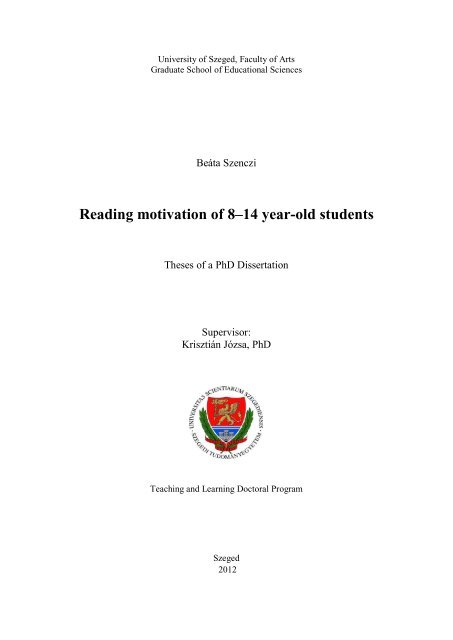
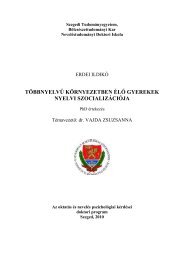

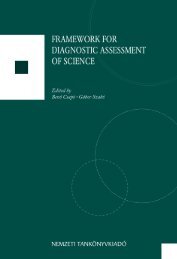
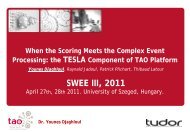

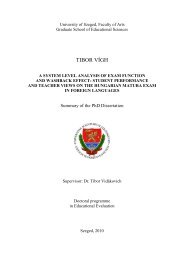
![Download [PDF] - Diagnosztikus Mérések Fejlesztése](https://img.yumpu.com/38928685/1/177x260/download-pdf-diagnosztikus-macracsek-fejlesztacse.jpg?quality=85)
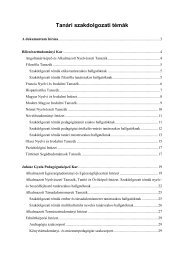
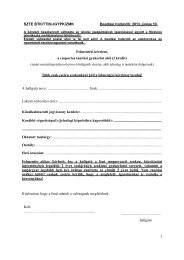

![Download [PDF] - Diagnosztikus Mérések Fejlesztése](https://img.yumpu.com/38928622/1/180x260/download-pdf-diagnosztikus-macracsek-fejlesztacse.jpg?quality=85)
